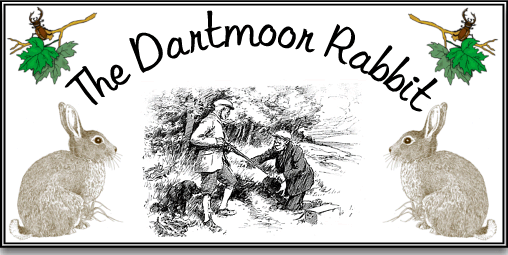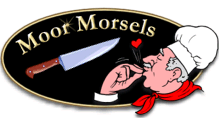
For centuries the rabbit has been a common feature on Dartmoor insomuch as there were numerous warrens where they were bred for their meat and skins. At first rabbit meat was a luxury only available to the nobility and was far beyond the reach of the average person. But by the 18th century rabbit meat became a food source for even the impoverished classes and a staple part of their diet. However, this is not to say that the odd coney or two never found its way into the crocks of the moor folk by surreptitious means, poaching was always a problem on the warrens. There is one story of a moorland poacher who got caught and was charged to appear in court where he recieved a fine for his troubles. On the way home from court he managed to poach enough rabbits to pay the cost of his recent fine. When the tinners or peat cutters were living out on the moor during their working week it was not easy to get fresh food supplies so the temptation was always there to take the odd rabbit. In recent times young lads would often earn their pocket money by catching rabbits and selling them on, one such example was the farmer at Headland Warren who would buy the rabbits and sell them on to a nearby commercial Fox Farm to feed the foxes. The local butchers would also buy rabbits for between 6d and 9d but more could be made by skinning them yourself and then selling the carcass locally and the skins to the travelling rag and bone men who would pay 4d for the pelt. It was not uncommon for folks living on the moor to send dead rabbits to members of their families in the cities which is nothing amazing until you realise that they went via the postal system, simply wrapped in newspaper.
Leaving the commercial warrens aside, the rabbits provided not only a food source for the farmers but also an extra income from the surplus. One way the money would be earned was to rent out the rabbiting rights to local trappers, these men would then come to the farm and by means of traps and snares catch the rabbits and then sell the skins and meat on. Prior to the myxomatosis outbreak it was nothing for these trappers to catch several hundred rabbits at a time. During harvest-time it would be nothing to cut a field of corn and find 80 odd rabbits hiding in the last block of cereals having been driven in their by the encircling harvester. On the moor Boxing Day was often a traditional occasion where the locals would go rabbiting with ferrets, guns and dogs, returning home afterwards to a meal of cold meats and pickle.
Much of the high moor is too wet for rabbits as they like relatively dry soils in which to make their burrows but where conditions allow they will thrive, these include clitter slopes and rocky valleys. On the edges of the moor the story is different and as with anywhere else they favour the cultivated farmlands and areas of gorse. The very nature of gorse provides shelter and protection for the rabbit and provides a fairly dry environment for them to live. Another feature of the Dartmoor landscape that proved popular with the rabbit was the stone and earth hedgebanks which provided ideal burrowing places, sometimes to the detriment of the hedge. Following the myxomatosis epidemic the rabbit numbers on the more drastically declined and whereas today people talk about a local rabbit populations of hundred originally the numbers would have been in their thousands.
Considering the commonality of the rabbit there is very little reference to it in local place names, there is an area of Cosdon Hill that was once known to be a favourite breeding site known as the ‘Rabbit’s Holt (OS grid reference – SX 641 924). A small tor to the east of Fox Tor has been called Rabbit’s Tor (OS grid reference SX 63582 69981) although there is no mention as to why. The only other place-names which allude to the rabbit are Conies Down, Tor, and Water, again there is no explanation as to be why and there is no nearby warren from which the name could allude.
As with anything that’s different from the natural norm, rabbits that have a black or darker coat are regarded with superstition and on Dartmoor these were thought to have been witches in disguise. Therefore it was regarded as being very unlucky to kill such a rabbit as the witch would exact her revenge once she had reverted to her human form. In a similar light, the sighting of a white rabbit was regarded as an omen of death or serious illness especially if one was spotted in the household garden.
Probably the most common folklore association with the rabbit is the ability of its foot to bring good luck to anyone who carried one, in addition it was also thought that a rabbit’s foot could cure a whole range of illnesses such as cramp and rheumatism.
The most interesting Dartmoor association with the rabbit is the ‘Tinner’s Rabbits‘ symbol which came to represent their profession. This is slightly misleading as today many suggest that the animal depicted in the symbol is in fact a hare not a rabbit but on Dartmoor they are always regarded as rabbits.
The most popular moorland rabbit used in cooked was the ‘Pie Rabbit’, this was one that had reached about 75% of its growth and was considered to provide much tenderer meat. The meat would normally be used in stews and pies along with the usual vegetables and pastry.

Dartmoor Rabbit Cider Pot
Ingredients
2lb (0.90 kg) wild rabbit joints (supermarket rabbit ‘ull do’ at a pinch)
4 rashers streaky bacon sliced into lardons (unsmoked)
2 ozs (56 gms) butter
1 tsp plain flour
6 ‘chipples’ (spring onions)
4 ozs (113 gms) field mushrooms
1 bay leaf
¾ pint (439ml) dry Devonshire Cider
Salt and Pepper
Method
Trim rabbit joints and soak overnight in cold salted water. Drain, rinse and dry before use. Heat butter in a large pan and fry for 10 minutes. 5 minutes into the cooking of the rabbit add the bacon pieces and cook for the remaining 5 minutes. Take out and place in the bottom of an oven proof casserole dish. Sprinkle with flour. Trim and diagonally slice the spring onions, wash and slice the mushrooms. Scatter mushroom and spring onions over the meat, season to taste and add the bay leaf. Pour over the cider. Cover and cook in the centre of a preheated oven 350°/gas mark 4 for 2 hours or until the rabbit is tender. Toss out the bay leaf, serve with wholegrain mustard mash potatoes and crusty bread with more Devon cider.
 Legendary Dartmoor The many aspects past and present of Dartmoor
Legendary Dartmoor The many aspects past and present of Dartmoor

